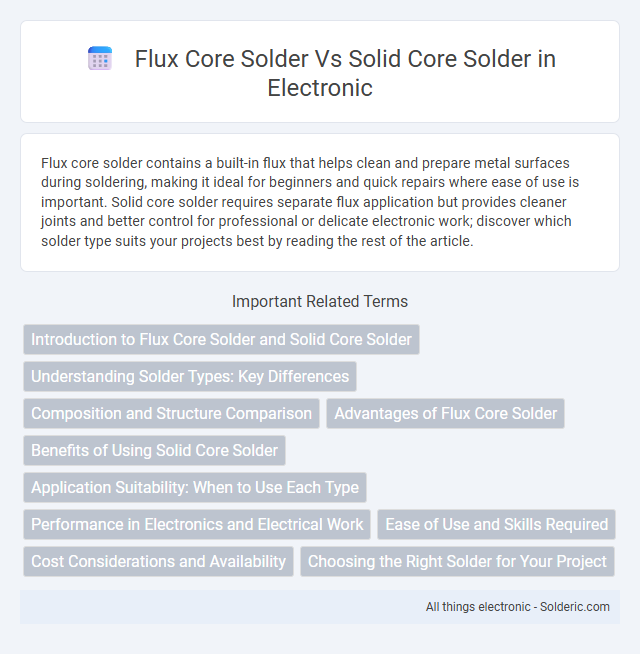Flux core solder contains a built-in flux that helps clean and prepare metal surfaces during soldering, making it ideal for beginners and quick repairs where ease of use is important. Solid core solder requires separate flux application but provides cleaner joints and better control for professional or delicate electronic work; discover which solder type suits your projects best by reading the rest of the article.
Comparison Table
| Feature | Flux Core Solder | Solid Core Solder |
|---|---|---|
| Composition | Contains flux within the core | Pure solder wire without flux |
| Application | Ideal for electronics, plumbing, and general repairs | Requires separate flux for electronics and delicate work |
| Ease of Use | Self-fluxing, reduces oxidation during soldering | Must apply flux manually for effective bonding |
| Residue | Flux residue may be corrosive; cleaning often necessary | No flux residue; cleaner joints after soldering |
| Cost | Typically slightly more expensive due to flux core | Generally less expensive, but added cost for flux |
| Best Use | Quick repairs and general purpose soldering | Precision electronics and situations needing clean joints |
Introduction to Flux Core Solder and Solid Core Solder
Flux core solder contains a hollow center filled with flux, which helps clean and prepare metal surfaces during soldering for better adhesion and electrical connectivity. Solid core solder lacks this built-in flux, requiring separate application to ensure proper joint formation and prevent oxidation. When choosing solder for your projects, understanding the differences between flux core and solid core solder is essential for achieving reliable and high-quality connections.
Understanding Solder Types: Key Differences
Flux core solder contains a built-in flux agent that cleans and prevents oxidation during the soldering process, making it ideal for electronics and plumbing applications where precision and strong joints are essential. Solid core solder requires external flux, offering more control for specialized tasks but adding an extra step to the preparation. Understanding these key differences helps you choose the appropriate solder type for your project, ensuring optimal performance and durability.
Composition and Structure Comparison
Flux core solder contains a hollow center filled with flux, enabling easier cleaning of oxidation during the soldering process, while solid core solder is a uniform alloy without internal flux, requiring separate flux application. The core flux in flux core solder improves flow and bonding by activating metal surfaces, whereas solid core solder relies purely on the alloy's melting properties. Choosing the right solder depends on your project's need for convenience and cleanliness versus precise control over flux application.
Advantages of Flux Core Solder
Flux core solder provides self-cleaning properties during the soldering process, effectively removing oxides and ensuring stronger, more reliable joints. It reduces the need for external flux application, saving time and minimizing contamination risks on electronic components. The flux core enhances heat transfer and improves overall solder flow, resulting in superior wettability and consistent electrical connections.
Benefits of Using Solid Core Solder
Solid core solder provides a cleaner, more precise weld due to its lack of flux impurities, reducing the risk of contamination in sensitive electronic components. It offers greater control for fine, detailed soldering tasks commonly required in electronics and jewelry making. This type of solder is ideal for projects demanding exacting standards of conductivity and appearance, as it produces minimal residue and requires additional flux application tailored to the specific job.
Application Suitability: When to Use Each Type
Flux core solder is ideal for applications where ease of use and effective oxidation removal during soldering are critical, particularly in electronics assembly and HVAC repairs. Solid core solder is best suited for environments where precise control over flux application is necessary, such as delicate circuit boards or when working with sensitive components. Choosing flux core solder enhances efficiency in quick repairs, while solid core solder offers cleaner joints in high-precision tasks.
Performance in Electronics and Electrical Work
Flux core solder provides superior performance in electronics and electrical work due to its built-in flux, which enhances solder flow and reduces oxidation, resulting in stronger, more reliable joints. Solid core solder requires an external flux application, increasing preparation time and potential for inconsistent soldering quality. For intricate circuit boards and delicate components, flux core solder ensures cleaner joints and better electrical conductivity, improving overall device performance and longevity.
Ease of Use and Skills Required
Flux core solder offers greater ease of use compared to solid core solder because the embedded flux eliminates the need for a separate flux application, reducing setup time and minimizing errors. It is particularly helpful for beginners or those with limited soldering experience, as the flux helps prevent oxidation and improves solder flow. You'll find flux core solder more forgiving, while solid core solder requires more precision and skill to apply flux separately and ensure proper joint quality.
Cost Considerations and Availability
Flux core solder generally costs more than solid core solder due to its integrated flux, which eliminates the need for separate flux application. Solid core solder is widely available and often preferred for its lower price and versatility, making it a cost-effective choice for standard soldering tasks. Your decision should weigh the convenience and application needs against budget and accessibility in your local market.
Choosing the Right Solder for Your Project
Selecting the right solder hinges on your project's requirements, where flux core solder offers built-in flux for improved joint cleaning and ease of use, especially in repairing or electronics work. Solid core solder requires external flux application, providing cleaner joints and better control in precision soldering, ideal for professional or high-quality tasks. Your choice depends on whether convenience or control takes priority in achieving durable, reliable solder connections.
flux core solder vs solid core solder Infographic

 solderic.com
solderic.com